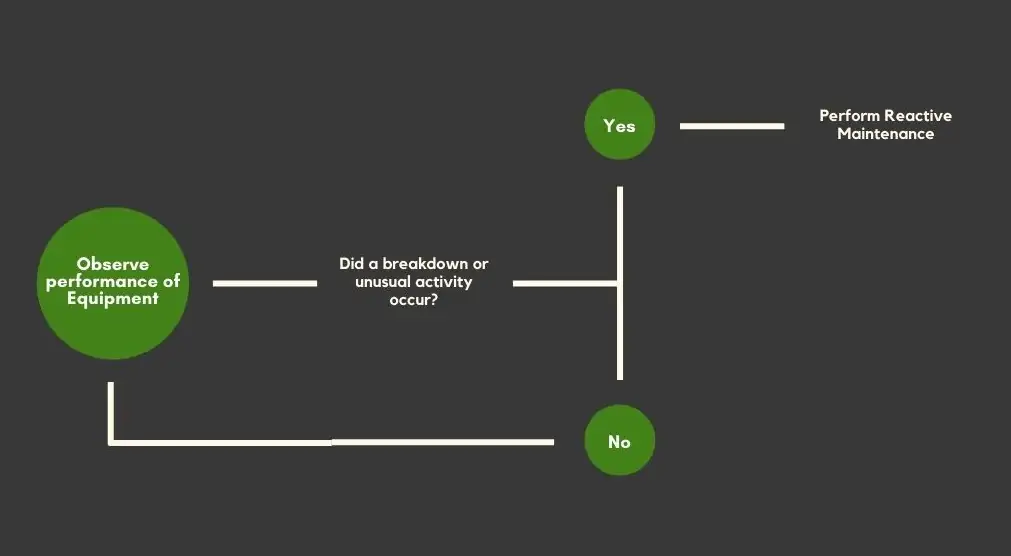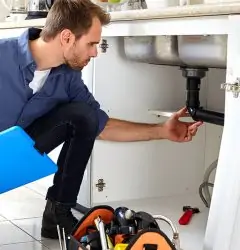02 Jun

Reactive maintenance refers to the process of asset repairing to their standard operating conditions after a breakdown, or low performance is observed. Some major benefits of reactive maintenance include lower costs and less human labor requirements.
These are repairs that are performed after the equipment has already broken down. Reactive maintenance and facilities management mainly focuses on bringing the equipment back to its operating conditions as soon as possible.
Emergency repairs are usually more expensive as compared to planned repairs, so the plans for maintenance that depend on reactive maintenance are typically the most expensive. One of its major reason is that breakdown occurs at the most crucial times, i.e., during periods of peak occupancy instead of off-hours. Moreover, the need to repair the equipment as fast as possible, operators are forced to rely on outside services that are expensive instead of availing maintenance from the in-house maintenance team.
What Does Reactive Maintenance Include?
Reactive maintenance is also known as run-to-failure or break down maintenance, and it is a process where repairs are performed on broken equipment. These repairs are not pre-planned, and hence this kind of maintenance is usually employed for assets that are not necessary for operations or are not that expensive to replace immediately.
There are various advantages and disadvantages of reactive maintenance, which we will further discuss. However, the most important aspect of this type of maintenance is that it requires less human effort and lower initial and planning costs as compared to other strategies of maintenance.
On the other hand, it usually makes it difficult to establish a budget and maintain an uninterrupted workflow when such unplanned maintenance issues appear. It not only leads to production loss but also disorganization and distraction at the workplace.
Simply put, it requires less time and money to wait for an asset to show signs of failure or break down completely as compared to performing routine maintenance. However, reactive maintenance is considered as a short-sighted approach. It serves as the best solution in emergencies, but it must not be the center of the maintenance plans and overall operations.
Completely depending on reactive maintenance is not a wise choice in the long term. It is better to adopt a maintenance routine for equipment that is essential for routine operations and productions. The maintenance routine must involve predictive maintenance, preventive maintenance, and routine maintenance.
Reactive Maintenance Workflow

According to Newton’s third law, for every action, there is an equal and opposite reaction.
This law reflects how forces interact with one another in relation to each others’ motion. However, it can be argued that it can be applied abstractly to a few everyday experiences. It is human nature to react to a situation and change the course of actions according to the situation’s requirement.
Fixing a broken piece of equipment seems like a basic reaction to a situation, and this is exactly what reactive maintenance is: a procedure of maintenance that focuses on dealing with issues as soon as they appear.
Checklist for Reactive Maintenance Program
In order to manage maintenance efficiently, a manager must establish a strategy to deal with emergency repairs. Here are six important steps to perform when setting up and managing emergency maintenance tasks. Some other elements of strategies can be added based on certain needs; however, these six are crucial.
Make a list of equipment that is reactively maintained
Not all assets are equal. Some assets are crucial for customer service and production processes, whereas other equipment is rarely used. Make a list of equipment that can be managed using reactive maintenance and does not require to be dealt with using PM. This list must include all the equipment that is seldom used and is not that critical for daily operations.
Ensuring that reactive maintenance is not more than fifteen percent of the total maintenance
Once you are done making a list, work on the needed reactive maintenance workload estimation. This work must not exceed fifteen percent of the total maintenance workload.
If any plant appears to be exceeding this tolerance, make sure to establish a strategy and move it away towards a predictive maintenance program. A CMMS system can help you to identify such critical equipment and areas where repairs are required. It can also enable you to set up and run proactive maintenance programs.
Developing, maintaining, and tracking KPIs
To effectively manage something, you must first measure it. This is the case when dealing with operations of complex maintenance. Essential KPIs must be developed to monitor the efficiency and impact of both the maintenance programs.
These KPIs include means time to repair, mean time between failures, productivity, quality of the product, planned downtime, etc. and they must be recorded and analyzed to identify negative and positive trends.
Formal procedure development for prompt emergency repairs
When an equipment failure occurs, it leads to disruption and disorganization within the workplace. These interruptions usually cost extra and impact negatively on budgets.
A well-managed organization must have pre-planned formal procedures to deal with emergency situations. It must be clear to everyone who, where, when, and how will deal with maintenance tasks. This allows an organization to run efficiently.
Stand-by Manpower
Maintenance operations involve emergency repairs, and they usually appear at unexpected times. A good reactive maintenance strategy must involve stand-by human labor and resources to perform maintenance tasks quickly and effectively.
Keeping an inventory of spares will also be required to ensure that maintenance repair tasks are performed without any interruptions and delays.
Managing preventive maintenance and ensuring that tasks of PM are performed within ten percent of the plan
The preventative maintenance program is developed to check the equipment regularly to avoid expensive repairs and production downtime. If the preventative maintenance plan is not followed closely, the chances of emergency breakdowns increase.
Not being prepared to deal with failures is a failure itself. Since no one can predict when a certain emergency might occur, it is a must to have a strategy in-hand to manage maintenance tasks as per requirements. A well-managed and effective reactive maintenance approach requires proper planning and strategy documenting along with formal procedures.
Types of Reactive Maintenance
Reactive maintenance can be used as a term to address maintenance tasks that are performed in response to emergency situations. There are various types of reactive maintenance.
Emergency Maintenance
It is referred to as an immediate activity of maintenance that is performed to keep equipment in operational condition. Emergency maintenance can sometimes be a response to emergency safety needs that are required to be dealt with as soon as possible. Such type of maintenance is typically prioritized, and hence it leads to production downtime and disruptions.
Breakdown Maintenance
When equipment stops working due to failure, a type of maintenance called breakdown maintenance is required. An asset that is declared non-operational but it can still be repaired can be maintained through breakdown maintenance.
Corrective Maintenance
During the maintenance procedures, some faults can appear. Such faults that are exposed while performing other tasks of maintenance can be dealt with through corrective maintenance.
Maintenance tasks that are typically unplanned or unexpected and are performed as a response to an emergency are identified as reactive maintenance.
Benefits of Reactive Maintenance
Here are some major reactive maintenance advantages:
No initial cost and planning is required as compared to preventive maintenance. The asset simply runs until the point when it breaks down.
It requires very little workforce at stand-by. Also, it does not need regular inspections and human labor to carry out the inspection processes. It can be outsourced easily.
It is the most cost-effective way to deal with emergency repairs of equipment that are not crucial for regular operations and create very minimal to zero impact on daily operations.
Disadvantages of Reactive Maintenance
Major disadvantages of reactive maintenance are:
Creating an accurate budget is difficult.
Depending on reactive maintenance frequently leads to unexpected downtime that can disrupt production schedules. It results in reduced profits and negative effects on the supply chain.
Poor management of time is also one of the disadvantages of reactive maintenance. Production can experience unnecessary delays due to unexpected equipment break down, and it often leads to time-taking asset repairs.
Unavailability of labor and spare parts can result in additional delays, losses, and downtime.
Due to emergencies, maintenance staff is under pressure to fix the problem as soon as possible and poses safety risks.
Completely relying on reactive maintenance might make your staff and organization disorganized, and work might get piled up. It results in inefficient behavior of workers as well as many tasks can get delayed.
Proactive Maintenance VS. Reactive Maintenance
Let’s have a deeper dive into the proactive maintenance vs. reactive maintenance equation
Proactive Maintenance
The terms preventive and proactive are often used interchangeably, but actually, they both are different from one another in many ways. Proactive maintenance can be referred to as a preventive approach which deals with identifying problems and failures and stop them from occurring. In contrast, a preventive maintenance program is responsible for scheduling work based on time or triggers (usage-based). Proactive maintenance’s approach is more focused. It takes into consideration the data collected by CMMS, condition-based monitoring, and machine sensor data to determine when maintenance tasks should be performed.
Reactive Maintenance
Reactive maintenance, on the other hand, is required when equipment has stopped working. It does not require any tracking, analysis, or anticipation. It is only performed as a reaction to an emergency.
Reactive maintenance is known to carry various negative aspects. Organizations that are still working with traditional maintenance systems such as paper and pen, and Excel, are more likely to fail in identifying failures due to their dependency on reactive maintenance.
Reactive vs. Proactive
Let’s discuss proactive vs. reactive maintenance:
Reactive maintenance can not be the core of an organization’s maintenance program. However, it can be a part of a reliable and well-balanced maintenance strategy. Reactive maintenance is based on the concept that anticipation and prevention of failure of equipment are not always effective or efficient.
However, creating a difference depends on how you decide which equipment comes under this category and how you are going to deal with them.
Comparision Between: Corrective or Reactive Maintenance
Corrective maintenance is defined as a process to maintain an asset and bring it back in its operational condition. This process involves failure identification, isolation, and repair.
For performing tasks of corrective maintenance, it is necessary that the equipment has either broke down or beginning to fail in a way that leads to higher failure risks. Therefore, preventive maintenance is not considered as a form of corrective maintenance as it is performed regularly.
There are two types of sub-categories of corrective maintenance:
- Reactive Maintenance: It occurs when the equipment has stopped working.
- Predictive Maintenance: It occurs after equipment has started to cause issues but before the point when it completely stops working.
Reactive maintenance’s other name is run-to-failure maintenance. It is a form of corrective maintenance. One common example is a tube light that is allowed to burn out so that it stops providing light and then gets replaced with a new one.
Planned VS. Reactive Maintenance
Planned Maintenance
It involves developing a schedule to check your assets regularly and deal with issues (if present).
Pros
- Fewer chances of unexpected failures.
- Longer lifetime of the system.
- Reduced bills, more money-saving.
- Minimal production downtime.
- Higher safety for workers and fewer chances of unfortunate events.
Cons
- High costs involved in setting up a planned maintenance program.
- It is a time taking process and requires you to pay extra attention while planning and setting up the maintenance schedule.
Reactive Maintenance
It is a process of carrying out maintenance once the failure occurs. It does not involve regular inspections.
Pros
- No initial cost is required.
- Less planning required.
- Easy to understand the maintenance approach.
- No regular costs to worry about.
Cons
- The wait-and-see maintenance approach is quite risky.
- It can be expensive and can disturb your budget.
- The process can be time-consuming, leading to increased production downtime.
- It can delay your deliveries, and you will end up having a bad reputation for it along with unsatisfied customers.
Final Thoughts
Reactive maintenance can play an essential role as a part of a well-developed and reliable maintenance strategy. Though in reactive maintenance situations are completely unexpected and unplanned and can be dealt with once the equipment has stopped working, it must not be the focus of your overall maintenance program. If you do so, you might end up at a loss and will have a disorganized organization as well as reduced profits.
It is better to opt for a planned maintenance program for equipment that is crucial for operations. However, assets that are not used frequently can be managed with reactive maintenance. Planned maintenance will allow you to maximize your equipment’s lifetime and reduce costs in the long term.




Ecodocs